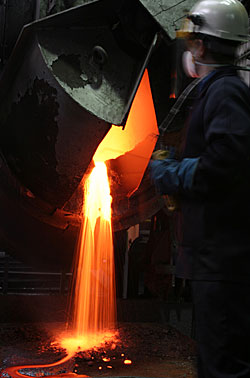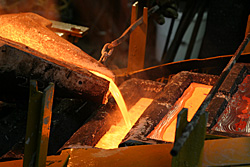Cupellation
The blast furnace produces a lead-silver metal alloy containing 25% - 50% silver and this will also include any gold or PGM’s. The lead is separated from the silver in a bottom-blown cupel.
The metal is melted in the cupel by a gas-fired burner, and oxygen is blown through the molten bath of metal. Oxygen preferentially oxidises the lead to form litharge (PbO), which is then poured off the top of the residual metal. Lead is converted to litharge until such time as the silver is 98%+ purity. The silver is poured, weighed, and sampled and transferred to the electrolytic refinery.
The litharge is recycled to the Blast Furnace.
The fume emissions from the cupel are ducted to a bag filter plant to capture fume and dust before discharging to the same stack as the blast furnace.
Fume and dusts are removed by the filter, mixed in water tanks, and combined with the slurry produced in the blast furnace bag filter. The dusts are recycled to the blast furnace.
Particulate emissions to atmosphere are continuously monitored with routine gas and metal emissions monitoring conducted as required by our environmental operating permit.
|
 |
   |